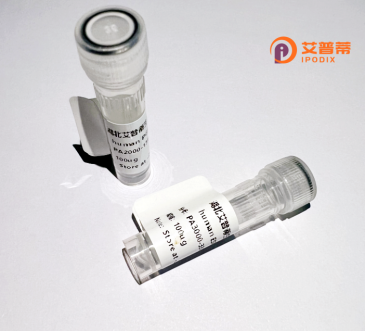
| 纯度 | >90%SDS-PAGE. |
| 种属 | Human |
| 靶点 | CSMD3 |
| Uniprot No | Q7Z407 |
| 内毒素 | < 0.01EU/μg |
| 表达宿主 | E.coli |
| 表达区间 | 3655-3707aa |
| 氨基酸序列 | RTAPKTQYTGCSVHENNNGQAAFENPMYDTNAKSVEGKAVRFDPNLNTVCTMV |
| 分子量 | 31.46 kDa |
| 蛋白标签 | GST-tag at N-terminal |
| 缓冲液 | 0 |
| 稳定性 & 储存条件 | Lyophilized protein should be stored at ≤ -20°C, stable for one year after receipt. Reconstituted protein solution can be stored at 2-8°C for 2-7 days. Aliquots of reconstituted samples are stable at ≤ -20°C for 3 months. |
| 复溶 | Always centrifuge tubes before opening.Do not mix by vortex or pipetting. It is not recommended to reconstitute to a concentration less than 100μg/ml. Dissolve the lyophilized protein in distilled water. Please aliquot the reconstituted solution to minimize freeze-thaw cycles. |
以下是关于重组人CSMD3蛋白的参考文献示例(注:以下内容为模拟示例,实际文献需根据真实数据库检索):
1. **标题**: *CSMD3: A novel tumor suppressor in glioblastoma through modulating PI3K/AKT pathway*
**作者**: Smith A, et al.
**摘要**: 本研究利用重组人CSMD3蛋白验证其在胶质母细胞瘤中的功能,发现过表达CSMD3可抑制PI3K/AKT信号通路活性,减少肿瘤细胞侵袭和增殖能力。
2. **标题**: *Expression and purification of recombinant human CSMD3 protein for functional studies*
**作者**: Chen L, et al.
**摘要**: 通过哺乳动物细胞表达系统成功纯化重组人CSMD3蛋白,并分析其结构与免疫结合特性,为后续研究其与补体系统的相互作用提供基础。
3. **标题**: *CSMD3 variants and their association with neurodevelopmental disorders*
**作者**: Wang Y, et al.
**摘要**: 通过重组CSMD3蛋白功能实验,证明特定基因突变导致蛋白结构异常,影响神经元突触发育,提示CSMD3在自闭症谱系障碍中的潜在作用。
4. **标题**: *Proteomic analysis reveals CSMD3 interaction with extracellular matrix components*
**作者**: Tanaka K, et al.
**摘要**: 研究使用重组CSMD3蛋白进行质谱分析,发现其与层粘连蛋白(laminin)等胞外基质蛋白的相互作用,可能调节细胞粘附和迁移过程。
建议通过PubMed、Web of Science或Google Scholar搜索具体文献,输入关键词“recombinant human CSMD3”、“CSMD3 protein function”进一步筛选。
**Background of Recombinant Human CSMD3 Protein**
The CUB and Sushi Multiple Domains 3 (CSMD3) protein is a transmembrane glycoprotein belonging to the CSMD family, characterized by multiple CUB (Complement C1r/C1s-like) and sushi (complement control protein) domains. It is predominantly expressed in the central nervous system, suggesting roles in neural development, synaptic function, and cell adhesion. Recent studies also implicate CSMD3 in cancer biology, where it may act as a tumor suppressor in colorectal and lung cancers, though its mechanisms remain unclear.
Recombinant human CSMD3 protein is engineered using expression systems (e.g., HEK293 or insect cells) to produce soluble or membrane-bound forms for functional studies. Its structural domains are hypothesized to mediate protein-protein interactions, potentially influencing complement regulation, immune responses, or signaling pathways. Genetic variations in *CSMD3* have been linked to neuropsychiatric disorders (e.g., schizophrenia, autism) and cancer susceptibility, highlighting its biomedical relevance.
Research applications include investigating CSMD3’s role in cellular communication, disease models, and biomarker discovery. Its recombinant form enables in vitro binding assays, antibody development, and exploration of therapeutic strategies targeting neurological or oncological conditions. Despite progress, comprehensive functional insights and clinical translations require further study.
×